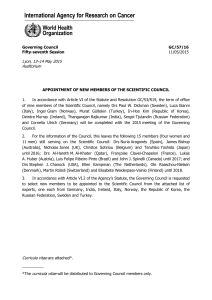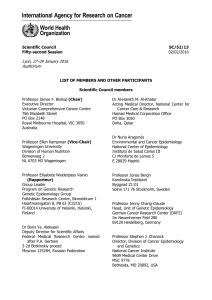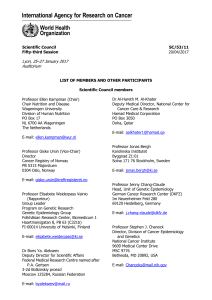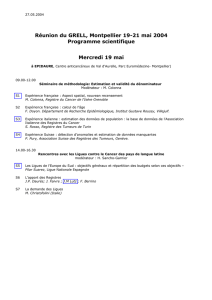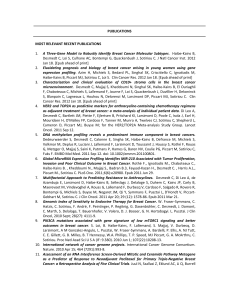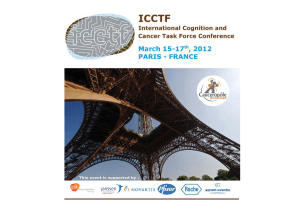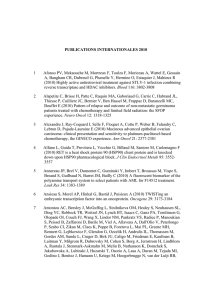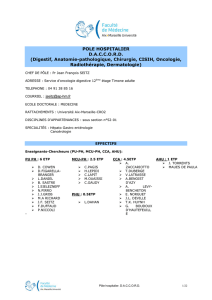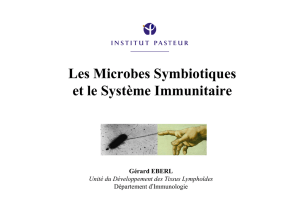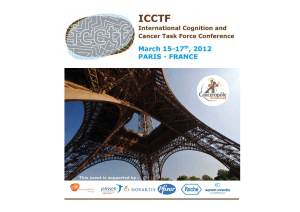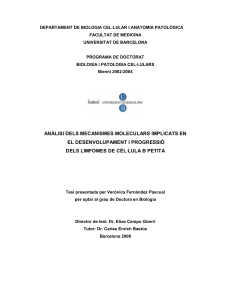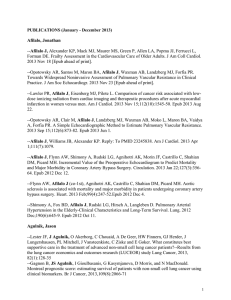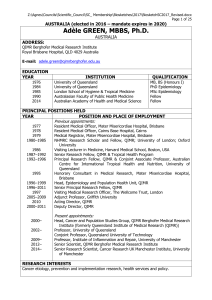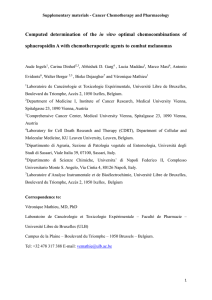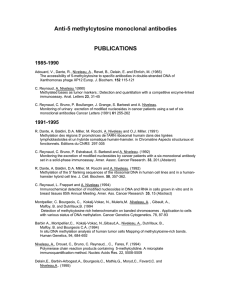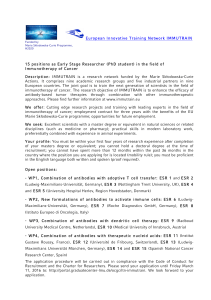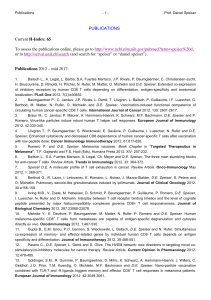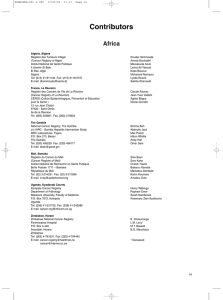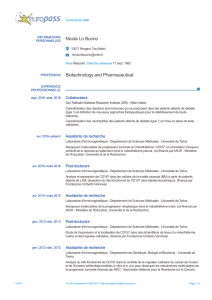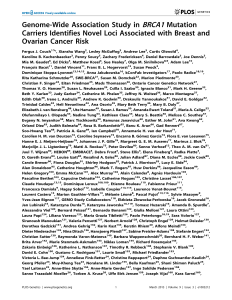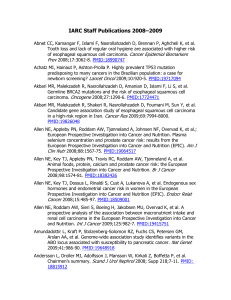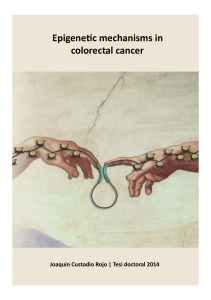06.VSC_BIBLIOGRAFIA.pdf
publicité
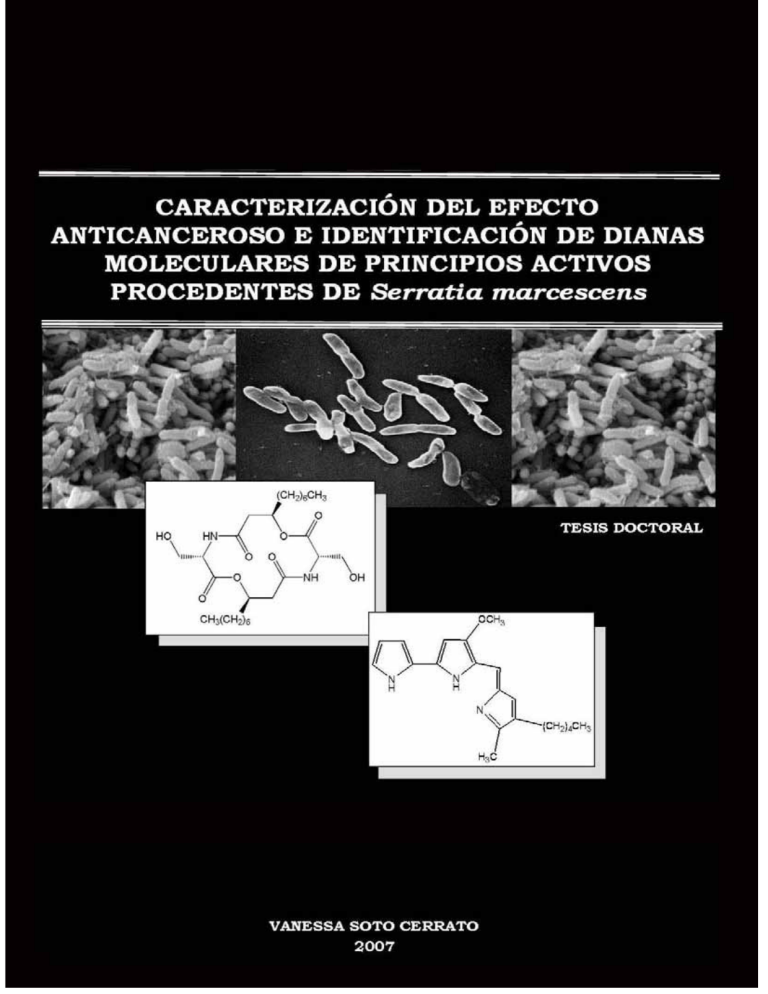
Facultat de Medicina Departament de Patologia i Terapèutica Experimental Programa de Doctorat: Biologia i Patologia Cel·lulars Bienni 2002-2004 “CARACTERIZACIÓN DEL EFECTO ANTICANCEROSO E IDENTIFICACIÓN DE DIANAS MOLECULARES DE PRINCIPIOS ACTIVOS PROCEDENTES DE Serratia marcescens” Memoria presentada por Vanessa Soto Cerrato para optar al grado de Doctor por la Universidad de Barcelona Dr. Ricardo E. Pérez Tomás Vanessa Soto Cerrato Director Doctoranda 2007 IX. BIBLIOGRAFÍA Bibliografía -AAdes T, Carlson RW, Edge SB, Kattlove H, McClure J, Rafine S, Smith ML. Cáncer de seno, guías de tratamiento para pacientes. Ed. American Cancer Society and National Comprehensive Cancer Networks, 2005. Allen EG. Conditions of the colour change of prodigiosin. Nature 1967;216:929. Aquilina G, Ceccotti S, Martinelli S, Soddu S, Crescenzi M, Branch P, Karran P, Bignami M. Mismatch repair and p53 independently affect sensitivity to N-(2-chloroethyl)N'-cyclohexyl-N-nitrosourea. Clin Cancer Res 2000;6(2):671-80. Aron JL, Parthun MR, Marcucci G, Kitada S, Mone AP, Davis ME, Shen T, Murphy T, Wickham J, Kanakry C, Lucas DM, Reed JC, Grever MR, Byrd JC. Depsipeptide (FR901228) induces histone acetylation and inhibition of histone deacetylase in chronic lymphocytic leukemia cells concurrent with activation of caspase 8-mediated apoptosis and down-regulation of c-FLIP protein. Blood 2003;102(2):652-8. -BBaek SJ, Wilson LC, Eling TE. Resveratrol enhances the expression of non-steroidal anti-inflammatory drug-activated gene (NAG-1) by increasing the expression of p53. Carcinogenesis 2002;23(3):425-34. Balamuth W, Brent MM. Biological studies on Entamoeba histolytica. IV. Direct action of the antibiotic, prodigiosin. Proc Soc Exp Biol Med 1950;75(2):374-8. Ballard CE, Yu H, Wang B. Recent developments in depsipeptide research. Curr Med Chem 2002;9(4):471-98. Bao Q, Shi Y. Apoptosome: a platform for the activation of initiator caspases. Cell Death Differ 2007;14(1):56-65. Bar-Ness R, Avrahamy N, Matsuyama T, Rosenberg M. Increased cell surface hydrophobicity of a Serratia marcescens NS 38 mutant lacking wetting activity. J Bacteriol 1988;170(9):4361-4. Barragán M, Bellosillo B, Campàs C, Colomer D, Pons G, Gil J. Involvement of protein kinase C and phosphatidylinositol 3-kinase pathways in the survival of B-cell chronic lymphocytic leukemia cells. Blood 2002;99(8):2969-76. Bennett JW, Bentley R. Seeing red: the story of prodigiosin. Adv Appl Microbiol 2000;47:1-32. Bizio B. Lettera di Bartolomeo Bizio al chiarissimo canonico Angelo Bellani sopra il fenomeno della polenta porporina. Biblioteca Italiana o sia Giornale di Letteratura, Scienze, e Arti, Tomo 30, Anno 8, Aprile, Maggio, Giugno, 1823, 275-295. Traducción al inglés: 225 Bibliografía Merlino CP. Bartolomeo Bizio's Letter to the most Eminent Priest, Angelo Bellani, Concerning the Phenomenon of the Red Colored Polenta. J Bacteriol 1924; 9(6): 527–43. Black RA, Kronheim SR, Merriam JE, March CJ, Hopp TP. A pre-aspartate-specific protease from human leukocytes that cleaves pro-interleukin-1 beta. J Biol Chem 1989;264(10):5323-6. Blanc C, Deveraux QL, Krajewski S, Janicke RU, Porter AG, Reed JC, Jaggi R, Marti A. Caspase-3 is essential for procaspase-9 processing and cisplatin-induced apoptosis of MCF-7 breast cancer cells. Cancer Res 2000;60(16):4386-90. Borràs JM, Borràs J, Bosch FX, Fernández E, Galceran J, Gispert R, González JR, Izquierdo A, Marcos R, Moreno V, Peris M, Puig X, Sánchez V, Viladiu P. Càncer Catalunya 2001. L'Hospitalet: Institut Català d'Oncologia, Departament de Sanitat i Seguretat Social; 2001. Bosch F. Aspectos generales sobre el ensayo clínico. Curso Monitorización de ensayos clínicos, ed. 2007. Col·legi Oficial de Metges de Barcelona. Brown AP, Morrissey RL, Faircloth GT, Levine BS. Preclinical toxicity studies of kahalalide F, a new anticancer agent: single and multiple dosing regimens in the rat. Cancer Chemother Pharmacol 2002;50(4):333-40. Bunting MI. A Description of Some Color Variants Produced by Serratia marcescens, Strain 274. J Bacteriol 1940;40(1):57-68. Burger SR, Bennett JW. Droplet enrichment factors of pigmented and nonpigmented Serratia marcescens: possible selective function for prodigiosin. Appl Environ Microbiol 1985;50(2):487-90. Byrd JC, Shinn C, Ravi R, Willis CR, Waselenko JK, Flinn IW, Dawson NA, Grever MR. Depsipeptide (FR901228): a novel therapeutic agent with selective, in vitro activity against human B-cell chronic lymphocytic leukemia cells. Blood 1999;94(4):1401-8. -CCastillo-Ávila W, Abal M, Robine S, Pérez-Tomás R. Non-apoptotic concentrations of prodigiosin (H+/Cl- symporter) inhibit the acidification of lysosomes and induce cell cycle blockage in colon cancer cells. Life Sci 2005;78(2):121-7. Castro AJ. Antimalarial activity of prodigiosin. Nature 1967;213(5079):903-4. Caulin C, Salvesen GS, Oshima RG. Caspase cleavage of keratin 18 and reorganization of intermediate filaments during epithelial cell apoptosis. J Cell Biol 1997;138(6):1379-94. Chalaux E, López-Rovira T, Rosa JL, Pons G, Boxer LM, Bartrons R, Ventura F. A zinc-finger transcription factor induced by TGF-beta promotes apoptotic cell death in epithelial Mv1Lu cells. FEBS Lett. 1999 Sep 3;457(3):478-82. 226 Bibliografía Cheng JQ, Lindsley CW, Cheng GZ, Yang H, Nicosia SV. The Akt/PKB pathway: molecular target for cancer drug discovery. Oncogene 2005;24(50):7482-92. Chinn LW y Kroetz DL. ABCB1 pharmacogenetics: progress, pitfalls, and promise. Clin Pharmacol Ther 2007;81(2):265-9. Coley WB. Late results of the treatment of inoperable sarcoma by the mixed toxins of erysipelas and Bacillus prodigiosus. Am J Med Sci 1906;131:375–430. Cory S y Adams JM. The Bcl2 family: regulators of the cellular life-or-death switch. Nat Rev Cancer 2002;2(9):647-56. Costa-Cros E, Castillo-Ávila W, Soto-Cerrato V, Llagostera E, Joshi R, Monge-Azemar M, Montaner B, Pérez-Tomás R. Estudio del efecto de prodigiosina sobre la ruta de PI3K/AKT. X Congreso Sociedad Española de Biología Celular. Santander, España, 18-21 Diciembre 2003. Cregan SP, Dawson VL, Slack RS. Role of AIF in caspase-dependent and caspaseindependent cell death. Oncogene 2004;23(16):2785-96. Cullen JC. The miracle of Bolsena. Growth of Serratia on sacramental breadand polenta may explain incidents in medieval Italy. Am Soc Microbiol News 1994;60:187-91. Cullen KJ, Newkirk KA, Schumaker LM, Aldosari N, Rone JD, Haddad BR. Glutathione S-transferase pi amplification is associated with cisplatin resistance in head and neck squamous cell carcinoma cell lines and primary tumors. Cancer Res 2003;63(23):8097-102. Cuní S, Pérez-Aciego P, Pérez-Chacón G, Vargas JA, Sánchez A, Martín-Saavedra FM, Ballester S, García-Marco J, Jorda J, Durantez A. A sustained activation of PI3K/NFkappaB pathway is critical for the survival of chronic lymphocytic leukemia B cells. Leukemia 2004;18(8):1391-400. -DD’Alessio R, Bargiotti A, Carlini O, Colotta F, Ferrari M, Gnocchi P, Isetta A, Mongelli N, Motta P, Rossi A, Rossi M, Tibolla M, Vanotti E. Synthesis and immunosuppressive activity of novel prodigiosin derivatives. J Med Chem 2000;43(13):2557-65. D’Auria MV, Zampella A, Paloma LG, Minale L, Debitus C, Roussakis C, Le Bert V. Callipeltins B and C; bioactive peptides from a marine Lithistida sponge Callipelta sp. Tetrahedron 1996;52:9589-96. Danial NN y Korsmeyer SJ. Cell death: critical control points. Cell 2004;116(2):205-19. Degli Esposti M y Dive C. Mitochondrial membrane permeabilisation by Bax/Bak. Biochem Biophys Res Commun 2003;304(3):455-61. 227 Bibliografía Depeille P, Cuq P, Mary S, Passagne I, Evrard A, Cupissol D, Vian L. Glutathione Stransferase M1 and multidrug resistance protein 1 act in synergy to protect melanoma cells from vincristine effects. Mol Pharmacol 2004;65(4):897-905. Derynck R y Zhang YE. Smad-dependent and Smad-independent pathways in TGF-beta family signalling. Nature 2003;425(6958):577-84. Díaz-Ruiz C, Montaner B, Pérez-Tomás R. Prodigiosin induces cell death and morphological changes indicative of apoptosis in gastric cancer cell line HGT-1. Histol Histopathol 2001;16(2):415-21. Dimri GP. What has senescence got to do with cancer? Cancer Cell 2005 Jun;7(6):50512. Doyle LA, Yang W, Abruzzo LV, Krogmann T, Gao Y, Rishi AK, Ross DD. A multidrug resistance transporter from human MCF-7 breast cancer cells. Proc Natl Acad Sci U S A 1998;95(26):15665-70. Duax W, Griffin JF, Langs DA, Smith GD, Grochulski P, Pletnev V, Ivanov V. Molecular structure and mechanisms of action of cyclic and linear ion transport antibiotics. Biopolymers 1996;40(1):141-55. -EEl-Deiry WS, Harper JW, O'Connor PM, Velculescu VE, Canman CE, Jackman J, Pietenpol JA, Burrell M, Hill DE, Wang Y, Wiman KG, W. Mercer E, Kastan MB, Kohn KW, Elledge SJ, Kinzler KW, Vogelstein B. WAF1/CIP1 is induced in p53-mediated G1 arrest and apoptosis. Cancer Res 1994;54(5):1169-74. Esteva FJ, Valero V, Pusztai L, Boehnke-Michaud L, Buzdar AU, Hortobagyi GN. Chemotherapy of metastatic breast cancer: what to expect in 2001 and beyond. Oncologist 2001;6(2):133-46. -FFaivre S, Chieze S, Delbaldo C, Ady-Vago N, Guzman C, López-Lázaro L, Lozahic S, Jimeno J, Pico F, Armand JP, Martín JA, Raymond E. Phase I and pharmacokinetic study of aplidine, a new marine cyclodepsipeptide in patients with advanced malignancies. J Clin Oncol 2005;23(31):7871-80. Fecteau KA, Mei J, Wang HC. Differential modulation of signaling pathways and apoptosis of ras-transformed 10T1/2 cells by the depsipeptide FR901228. J Pharmacol Exp Ther. 2002 Mar;300(3):890-9. Fritz A, Percy C, Jack A, Shanmugaratnam K, Sobin L, Parkin DM, Whelan S. International classification of diseases for Oncology. Third edition (International Association for Cancer Registries Ed.) 2000. 228 Bibliografía Frova C. Glutathione transferases in the genomics era: new insights and perspectives. Biomol Eng 2006;23(4):149-69. Fujiwara H, Yamakuni T, Ueno M, Ishizuka M, Shinkawa T, Isobe T, Ohizumi Y. IC101 induces apoptosis by AKT dephosphorylation via an inhibition of heat shock protein 90-ATP binding activity accompanied by preventing the interaction with AKT in L1210 cells. J Pharmacol Exp Ther 2004;310(3):1288-95. -GGarcía-Rocha M, Bonay P, Ávila J. The antitumoral compound Kahalalide F acts on cell lysosomes. Cancer Lett 1996;99(1):43-50. Gartel AL, Serfas MS, Tyner AL. p21-negative regulator of the cell cycle. Proc Soc Exp Biol Med 1996;213:138–49. Gartel AL, Tyner AL. Transcriptional regulation of the p21 (WAF1/CIP1) gene. Exp Cell Res 1999;246:280–9. Gaughran ER. From superstition to science: the history of a bacterium. Trans N Y Acad Sci 1969;31(1):3-24. Geldof AA, Mastbergen SC, Henrar RE, Faircloth GT. Cytotoxicity and neurocytotoxicity of new marine anticancer agents evaluated using in vitro assays. Cancer Chemother Pharmacol 1999;44(4):312-8. Gerber NN, Gauthier M. New prodigiosin-like pigment from Alteromonas rubra. Appl Environ Microbiol 1979;37(6):1176-9. Gerber NN. A new prodiginne (prodigiosin-like) pigment from Streptomyces. Antimalarial activity of several prodiginines. J Antibiot (Tokyo) 1975b;28(3):194-9. Gerber NN. Prodigiosin-like pigments from Actinomadura (Nocardia) pelletieri and Actinomadura madurae. Appl Microbiol 1969;18(1):1-3. Gerber NN. Prodigiosin-like pigments. CRC Crit Rev Microbiol 1975a;3(4):469-85. Gottesman MM, Fojo T, Bates SE. Multidrug resistance in cancer: role of ATPdependent transporters. Nat Rev Cancer 2002;2(1):48-58. Grabowski DT, Pieper RO, Futscher BW, Deutsch WA, Erickson LC, Kelley MR. Expression of ribosomal phosphoprotein PO is induced by antitumor agents and increased in Mer- human tumor cell lines. Carcinogenesis 1992;13(2):259-63. Green DR, Reed JC. Mitochondria and apoptosis. Science 1998;281(5381):1309-12. Grimont F, Grimont PAD The genus Serratia. In “The procaryotes” (Balows A, Trüper HG, Dworkin M, Harder W, Schleifer KH, eds.; Springer-Verlag, New York) 1991;3:282248. 229 Bibliografía -HHamada Y, Shioiri T. Recent progress of the synthetic studies of biologically active marine cyclic peptides and depsipeptides. Chem Rev 2005;105(12):4441-82. Hamann MT. Technology evaluation: Kahalalide F, PharmaMar. Curr Opin Mol Ther 2004;6(6):657-65. Han SB, Kim HM, Kim YH, Lee CW, Jang ES, Son KH, Kim SU, Kim YK. T-cell specific immunosuppression by prodigiosin isolated from Serratia marcescens. Int J Immunopharmacol 1998;20(1-3):1-13. Han SB, Park SH, Jeon YJ, Kim YK, Kim HM, Yang KH. Prodigiosin blocks T cell activation by inhibiting interleukin-2Ralpha expression and delays progression of autoimmune diabetes and collagen-induced arthritis. J Pharmacol Exp Ther 2001;299(2):415-25. Hanahan D, Weinberg RA. The hallmarks of cancer. Cell 2000;100(1):57-70. Harbottle A, Daly AK, Atherton K, Campbell FC. Role of glutathione S-transferase P1, P-glycoprotein and multidrug resistance-associated protein 1 in acquired doxorubicin resistance. Int J Cancer 2001;92(6):777-83. Hearn WR, Elson MK, Williams RH, Medina-Castro J. Prodigiosene [5-(2-pyrryl)-2,2-'dipyrrylmethene] and some substituted prodigiosenes. J Org Chem 1970;35(1):142-6. Hearn WR, Medina-Castro J, Elson MK. Colour change of prodigiosin. Nature 1968;220(5163):170-1. Hedge VR, Dai P, Patel M, Das PR, Wang S, Puar MS. A depsipeptide fungal metabolite inhibitor of cholesteryl ester transfer protein. Bioorg Med Chem Lett 1998;8(11):1277-80. Hejazi A, Falkiner FR. Serratia marcescens. J Med Microbiol 1997;46(11):903-12. Holt JG, Krieg NR, Sneath PHA, Staley JT, Williams ST. “Bergey’s Manual of Determinative Bacteriology”. Ninth ed, 1994. Williams & Wilkins ed. Baltimore (USA). Hood DW, Heidstra R, Swoboda UK, Hodgson DA. Molecular genetic analysis of proline and tryptophan biosynthesis in Streptomyces coelicolor A3(2): interaction between primary and secondary metabolism. Gene 1992;115(1-2):5-12. Hubbard R, Rimington C. The biosynthesis of prodigiosin, the tripyrrylmethene pigment from Bacillus prodigiosus (Serratia marcescens). Biochem J 1950;46(2):220-5. Hurley LH. DNA and its associated processes as targets for cancer therapy. Nat Rev Cancer 2002;2(3):188-200. Hwang Y, Rowley D, Rhodes D, Gertsch J, Fenical W, Bushman F. Mechanism of inhibition of a poxvirus topoisomerase by the marine natural product sansalvamide A. Mol Pharmacol 1999;55:1049-53. 230 Bibliografía -JJanmaat ML, Rodriguez JA, Jimeno J, Kruyt FA, Giaccone G. Kahalalide F induces necrosis-like cell death that involves depletion of ErbB3 and inhibition of AKT signaling. Mol Pharmacol 2005;68(2):502-10. Jemal A, Siegel R, Ward E, Murray T, Xu J, Thun MJ. Cancer statistics, 2007. CA Cancer J Clin 2007;57(1):43-66. Jeong H, Yim JH, Lee C, Choi SH, Park YK, Yoon SH, Hur CG, Kang HY, Kim D, Lee HH, Park KH, Park SH, Park HS, Lee HK, Oh TK, Kim JF. Genomic blueprint of Hahella chejuensis, a marine microbe producing an algicidal agent. Nucleic Acids Res 2005;33(22):7066-73. Juliano RL, Ling V. A surface glycoprotein modulating drug permeability in Chinese hamster ovary cell mutants. Biochim Biophys Acta 1976;455(1):152-62. -KKalbe C, Marten P, Berg G. Strains of the genus Serratia as beneficial rhizobacteria of oilseed rape with antifungal properties. Microbiol Res 1996;151(4):433-9. Kandel ES y Hay N. The regulation and activities of the multifunctional serine/threonine kinase AKT/PKB. Exp Cell Res 1999;253(1):210-29. Kang Y, Chen CR, Massagué J. A self-enabling TGF-beta response coupled to stress signaling: Smad engages stress response factor ATF3 for Id1 repression in epithelial cells. Mol Cell 2003;11(4):915-26. Kasibhatla S, Tseng B. Why target apoptosis in cancer treatment? Mol Cancer Ther 2003;2(6):573-80. Kastan MB. Wild-type p53: tumors can't stand it. Cell 2007;128(5):837-40. Kato A, Nakaya S, Kokubo N, Aiba Y, Ohashi Y, Hirata H, Fujii K, Harada K. A new anti-MRSA antibiotic complex, WAP-8294A. I. Taxonomy, isolation and biological activities. J Antibiot (Tokyo) 1998;51(10):929-35. Kawauchi K, Shibutani K, Yagisawa H, Kamata H, Nakatsuji S, Anzai H, Yokoyama Y, Ikegami Y, Moriyama Y, Hirata H. A possible immunosuppressant, cycloprodigiosin hydrochloride, obtained from Pseudoalteromonas denitrificans. Biochem Biophys Res Commun 1997;237(3):543-7. Kerr JF, Wyllie AH, Currie AR. Apoptosis: a basic biological phenomenon with wideranging implications in tissue kinetics. Br J Cancer 1972;26(4):239-57. Kim HS, Hayashi M, Shibata Y, Wataya Y, Mitamura T, Horii T, Kawauchi K, Hirata H, Tsuboi S, Moriyama Y. Cycloprodigiosin hydrochloride obtained from Pseudoalteromonas denitrificans is a potent antimalarial agent. Biol Pharm Bull 1999;22(5):532-4. 231 Bibliografía Klisovic D, Katz SE, Effron D, Klisovic MI, Wickham J, Parthun MR, Guimond M, Marcucci G. Depsipeptide (FR901228) inhibits proliferation and induces apoptosis in primary and metastatic human uveal melanoma cell lines. Invest Ophthalmol Vis Sci 2003;44(6):2390-8. Kobayashi N, Ichikawa Y. A protein associated with prodigiosin formation in Serratia marcescens. Microbiol Immunol 1989;33(4):257-63. Konno H, Matsuya H, Okamoto M, Sato T, Tanaka Y, Yokoyama K, Kataoka T, Nagai K, Wasserman HH, Ohkuma S. Prodigiosins uncouple mitochondrial and bacterial FATPases: evidence for their H+/Cl- symport activity. J Biochem (Tokyo) 1998;124(3):54756. Konstantinopoulos PA, Vandoros GP, Papavassiliou AG. FK228 (depsipeptide): a HDAC inhibitor with pleiotropic antitumor activities. Cancer Chemother Pharmacol 2006;58(5):711-5. Korsmeyer SJ, Wei MC, Saito M, Weiler S, Oh KJ, Schlesinger PH. Pro-apoptotic cascade activates BID, which oligomerizes BAK or BAX into pores that result in the release of cytochrome c. Cell Death Differ 2000;7(12):1166-73. Kraft E. Beitrage zur biologie des B. prodigiosus und zum chemischen verhalten seines pigments, PhD thesis, University of Wurzburg, Germany, 1902. Kramer G, Erdal H, Mertens HJ, Nap M, Mauermann J, Steiner G, Marberger M, Biven K, Shoshan MC, Linder S. Differentiation between cell death modes using measurements of different soluble forms of extracellular cytokeratin 18. Cancer Res 2004;64(5):1751-6. Kratz F, Abu Ajaj K, Warnecke A. Anticancer carrier-linked prodrugs in clinical trials. Expert Opin Investig Drugs 2007;16(7):1037-58. Kroemer G, El-Deiry WS, Golstein P, Peter ME, Vaux D, Vandenabeele P, Zhivotovsky B, Blagosklonny MV, Malorni W, Knight RA, Piacentini M, Nagata S, Melino G; Nomenclature Committee on Cell Death. Classification of cell death: recommendations of the Nomenclature Committee on Cell Death. Cell Death Differ 2005;12 Suppl 2:1463-7. Kroemer G, Galluzzi L, Brenner C. Mitochondrial membrane permeabilization in cell death. Physiol Rev 2007;87(1):99-163. Kroemer G, Zamzami N, Susin SA. Mitochondrial control of apoptosis. Immunol Today 1997;18(1):44-51. Kumar S. Caspase function in programmed cell death. Cell Death Differ 2007;14(1):3243. -LLambert JR, Kelly JA, Shim M, Huffer WE, Nordeen SK, Baek SJ, Eling TE, Lucia MS. Prostate derived factor in human prostate cancer cells: gene induction by vitamin D via 232 Bibliografía a p53-dependent mechanism and inhibition of prostate cancer cell growth. J Cell Physiol 2006;208(3):566-74. Lee MH, Kataoka T, Magae J, Nagai K. Prodigiosin 25-C suppression of cytotoxic T cells in vitro and in vivo similar to that of concanamycin B, a specific inhibitor of vacuolar type H(+)-ATPase. Biosci Biotechnol Biochem 1995;59(8):1417-21. Li PX, Wong J, Ayed A, Ngo D, Brade AM, Arrowsmith C, Austin RC, Klamut HJ. Placental transforming growth factor- is a downstream mediator of the growth arrest and apoptotic response of tumor cells to DNA damage and p53 overexpression. J Biol Chem 2000;275(26):20127-35. Liang H, Salinas RA, Leal BZ, Kosakowska-Cholody T, Michejda CJ, Waters SJ, Herman TS, Woynarowski JM, Woynarowska BA. Caspase-mediated apoptosis and caspase-independent cell death induced by irofulven in prostate cancer cells. Mol Cancer Ther 2004;3(11):1385-96. Litman T, Druley TE, Stein WD, Bates SE. From MDR to MXR: new understanding of multidrug resistance systems, their properties and clinical significance. Cell Mol Life Sci 2001;58(7):931-59. Liu R, Cui CB, Duan L, Gu QQ, Zhu WM. Potent in vitro anticancer activity of metacycloprodigiosin and undecylprodigiosin from a sponge-derived actinomycete Saccharopolyspora sp. nov. Arch Pharm Res 2005;28(12):1341-4. Liu T, Bauskin AR, Zaunders J, Brown DA, Pankhurst S, Russell PJ, Breit SN. Macrophage inhibitory cytokine 1 reduces cell adhesion and induces apoptosis in prostate cancer cells. Cancer Res 2003;63(16):5034-40. Locksley RM, Killeen N, Lenardo MJ. The TNF and TNF receptor superfamilies: integrating mammalian biology. Cell 2001;104(4):487-501. Loren JG, Guinea J. Effect of glucose concentration on the biosynthesis of prodigiosin by serratia marcescens. Rev Esp Fisiol 1978;34(3):247-52. Lowe SW, Ruley HE, Jacks T, Housman DE. P53-dependent apoptosis modulates the cytotoxicity of anticancer agents. Cell 1993;74:957-67. Luo X, Budihardjo I, Zou H, Slaughter C, Wang X. Bid, a Bcl2 interacting protein, mediates cytochrome c release from mitochondria in response to activation of cell surface death receptors. Cell 1998;94(4):481-90. -MMadigan MT, Martinko JM, Parker J. La pared celular de los procariotas en “Brock, Biología de los microorganismos” (Ed. Pearson, Prentice Hall, 10ª ed.) Capítulo 4:74-81. 233 Bibliografía Madrid LV, Wang CY, Guttridge DC, Schottelius AJ, Baldwin AS Jr, Mayo MW. AKT suppresses apoptosis by stimulating the transactivation potential of the RelA/p65 subunit of NF-kappaB. Mol Cell Biol 2000;20(5):1626-38. Magae J, Miller MW, Nagai K, Shearer GM. Effect of metacycloprodigiosin, an inhibitor of killer T cells on murine skin and heart transplants. J Antibiot (Tokyo) 1996;49(1):86-90. Mallick SA. Cell surface hydrophobicity and its relation to outer membrane proteins of Serratia marcescens. Indian J Exp Biol 1996;34(2):107-10. Manderville RA. Synthesis, proton-affinity and anti-cancer properties of the prodigiosin-group natural products. Curr Med Chem Anticancer Agents 2001;1(2):195-218. Marahiel MA, Stachelhaus T, Mootz HD. Modular peptide synthetases involved in nonribosomal peptide synthesis. Chem Rev 1997;97:2651-73. Marshall KM, Matsumoto SS, Holden JA, Concepcion GP, Tasdemir D, Ireland CM, Barrows LR. The anti-neoplastic and novel topoisomerase II-mediated cytotoxicity of neoamphimedine, a marine pyridoacridine. Biochem Pharmacol 2003;66(3):447-58. Massagué J, Blain SW, Lo RS. TGF- signaling in growth control, cancer, and heritable disorders. Cell 2000;103:295–309. Massagué J, Gomis RR. The logic of TGFbeta signaling. FEBS Lett 2006;580(12):2811-20. Matsuyama T, Sogawa M, Nakagawa Y. Fractal spreading growth of Serratia marcescens which produces surface active exolipids. FEMS Microbiol Lett 1989;52(3):2436. McCubrey JA, Steelman LS, Abrams SL, Lee JT, Chang F, Bertrand FE, Navolanic PM, Terrian DM, Franklin RA, D'Assoro AB, Salisbury JL, Mazzarino MC, Stivala F, Libra M. Roles of the RAF/MEK/ERK and PI3K/PTEN/AKT pathways in malignant transformation and drug resistance. Adv Enzyme Regul 2006;46:249-79. McGrath T y Center MS. Adriamycin resistance in HL60 cells in the absence of detectable P-glycoprotein. Biochem Biophys Res Commun 1987;145(3):1171-6. Melvin MS, Calcutt MW, Noftle RE, Manderville RA. Influence of the a-ring on the redox and nuclease properties of the prodigiosins: importance of the bipyrrole moiety in oxidative DNA cleavage. Chem Res Toxicol 2002;15(5):742-8. Melvin MS, Ferguson DC, Lindquist N, Manderville RA. DNA Binding by 4Methoxypyrrolic Natural Products. Preference for Intercalation at AT Sites by Tambjamine E and Prodigiosin. J Org Chem 1999;64(18):6861-9. Menéndez JA, del Mar Barbacid M, Montero S, Sevilla E, Escrich E, Solanas M, Cortés-Funes H, Colomer R. Effects of gamma-linolenic acid and oleic acid on paclitaxel cytotoxicity in human breast cancer cells. Eur J Cancer 2001;37(3):402-13. 234 Bibliografía Menéndez JA, Ropero S, del Barbacid MM, Montero S, Solanas M, Escrich E, CortésFunes H, Colomer R. Synergistic interaction between vinorelbine and gamma-linolenic acid in breast cancer cells. Breast Cancer Res Treat 2002;72(3):203-19. Miyazaki Y, Oka S, Hara-Hotta H, Yano I. Increased cell surface hydrophobicity of a Serratia marcescens NS 38 mutant lacking wetting activity. J Bacteriol 1988;170(9):43614. Miyazawa K, Shinozaki M, Hara T, Furuya T, Miyazono K. Two major Smad pathways in TGF-beta superfamily signalling. Genes Cells 2002;7(12):1191-204. Montaner B y Pérez-Tomás R. The cytotoxic prodigiosin induces phosphorylation of p38-MAPK but not of SAPK/JNK. Toxicol Lett 2002;129(1-2):93-8. Montaner B, Castillo-Ávila W, Martinell M, Ollinger R, Aymami J, Giralt E, PérezTomás R. DNA interaction and dual topoisomerase I and II inhibition properties of the antitumor drug prodigiosin. Toxicol Sci 2005;85(2):870-9. Montaner B, Navarro S, Piqué M, Vilaseca M, Martinell M, Giralt E, Gil J, PérézTomás R. Prodigiosin from the supernatant of Serratia marcescens induces apoptosis in haematopoietic cancer cell lines. Br J Pharmacol 2000;131(3):585-93. Montaner B, Pérez-Tomás R. Prodigiosin induces caspase-9 and caspase-8 activation and cytochrome C release in Jurkat T cells. Ann N Y Acad Sci 2002;973:246-9. Montaner B, Pérez-Tomás R. Prodigiosin-induced apoptosis in human colon cancer cells. Life Sci 2001;68(17):2025-36. Montaner B, Pérez-Tomás R. The prodigiosins: a new family of anticancer drugs. Curr Cancer Drug Targets 2003;3(1):57-65. Moon SK, Choi YH, Kim CH, Choi WS. p38MAPK mediates benzyl isothiocyanateinduced p21WAF1 expression in vascular smooth muscle cells via the regulation of Sp1. Biochem Biophys Res Commun 2006;350(3):662-8. Mortellaro A, Songia S, Gnocchi P, Ferrari M, Fornasiero C, D'Alessio R, Isetta A, Colotta F, Golay J. New immunosuppressive drug PNU156804 blocks IL-2-dependent proliferation and NF-kappa B and AP-1 activation. J Immunol 1999;162(12):7102-9. -NNakajima M. The mechanism of prodigiosin biosynthesis. Bull Osaka Med Sch 1965;11:39. Nakamura A, Magae J, Tsuji RF, Yamasaki M, Nagai K. Suppression of cytotoxic T cell induction in vivo by prodigiosin 25-C. Transplantation 1989;47(6):1013-6. Nakashima T, Miyazaki Y, Matsuyama Y, Muraoka W, Yamaguchi K, Oda T. Producing mechanism of an algicidal compound against red tide phytoplankton in a marine bacterium gamma-proteobacterium. Appl Microbiol Biotechnol 2006;73(3):684-90. 235 Bibliografía Namatame I, Tomoda H, Si S, Yamaguchi Y, Masuma R, Omura S. Beauveriolides, specific inhibitors of lipid droplet formation in mouse macrophages, produced by Beauveria sp. FO-6979. J Antibiot (Tokyo) 1999;52(1):1-6. Nazarova N, Qiao S, Golovko O, Lou YR, Tuohimaa P. Calcitriol-induced prostatederived factor: autocrine control of prostate cancer cell growth. Int J Cancer 2004;112(6):951-8. Newman DJ, Cragg GM. Natural products as sources of new drugs over the last 25 years. J Nat Prod 2007;70(3):461-77. Nicolaou KC, Boddy CN, Brase S, Winssinger N. Chemistry, Biology, and Medicine of the Glycopeptide Antibiotics. Angew Chem Int Ed Engl 1999;38(15):2096-152. Nishida J, Shiratsuchi A, Nadano D, Sato TA, Nakanishi Y. Structural change of ribosomes during apoptosis: degradation and externalization of ribosomal proteins in doxorubicin-treated Jurkat cells. J Biochem (Tokyo) 2002;131(3):485-93. Nooter K, Westerman AM, Flens MJ, Zaman GJ, Scheper RJ, van Wingerden KE, Burger H, Oostrum R, Boersma T, Sonneveld P, Gratama JW, Kok T, Eggermont AMM, Bosman FT, Stoter G. Expression of the multidrug resistance-associated protein (MRP) gene in human cancers. Clin Cancer Res 1995;1(11):1301-10. -OOhkuma S, Sato T, Okamoto M, Matsuya H, Arai K, Kataoka T, Nagai K, Wasserman HH. Prodigiosins uncouple lysosomal vacuolar-type ATPase through promotion of H+/Clsymport.Biochem J 1998;334 (Pt 3):731-41. Omary MB, Ku NO, Tao GZ, Toivola DM, Liao J. "Heads and tails" of intermediate filament phosphorylation: multiple sites and functional insights. Trends Biochem Sci 2006;31(7):383-94. Oshima RG. Apoptosis and keratin intermediate filaments. Cell Death Differ 2002;9(5):486-92. -PPaal K, Shkarupin A, Beckford L. Paclitaxel binding to human serum albumin-automated docking studies. Bioorg Med Chem 2007;15(3):1323-9. Pap M y Cooper GM. Role of glycogen synthase kinase-3 in the phosphatidylinositol 3Kinase/AKT cell survival pathway. J Biol Chem 1998;273(32):19929-32. Pardali K, Kurisaki A, Moren A, ten Dijke P, Kardassis D, Moustakas A. Role of Smad proteins and transcription factor Sp1 in p21(Waf1/Cip1) regulation by transforming growth factor-beta. J Biol Chem 2000;275(38):29244-56. 236 Bibliografía Peart MJ, Tainton KM, Ruefli AA, Dear AE, Sedelies KA, O'Reilly LA, Waterhouse NJ, Trapani JA, Johnstone RW. Novel mechanisms of apoptosis induced by histone deacetylase inhibitors. Cancer Res 2003;63(15):4460-71. Pec MK, Aguirre A, Moser-Thier K, Fernandez JJ, Souto ML, Dorta J, Diaz-Gonzalez F, Villar J. Induction of apoptosis in estrogen dependent and independent breast cancer cells by the marine terpenoid dehydrothyrsiferol. Biochem Pharmacol 2003;65(9):1451-61. Pérez-Tomás R, Montaner B, Llagostera E, Soto-Cerrato V. The prodigiosins, proapoptotic drugs with anticancer properties. Biochem Pharmacol 2003;66(8):1447-52. Pérez-Tomás R, Montaner B. Effects of the proapoptotic drug prodigiosin on cell cyclerelated proteins in Jurkat T cells. Histol Histopathol 2003;18(2):379-85. Pérez-Tomás R. Multidrug resistance: retrospect and prospects in anti-cancer drug treatment. Curr Med Chem. 2006;13(16):1859-76. Peter ME, Krammer PH. The CD95(APO-1/Fas) DISC and beyond. Cell Death Differ 2003;10(1):26-35. Plas DR, Thompson CB. Akt-dependent transformation: there is more to growth than just surviving. Oncogene 2005;24(50):7435-42. Poo JL, Rosas-Romero R, Montemayor AC, Isoard F, Uribe M. Diagnostic value of the copper/zinc ratio in hepatocellular carcinoma: a case control study. J Gastroenterol 2003;38(1):45-51. Portugal J, Martín B, Vaquero A, Ferrer N, Villamarín S, Priebe W. Analysis of the effects of daunorubicin and WP631 on transcription. Curr Med Chem 2001;8(1):1-8. Purkayastha M, Williams RP. Association of pigment with the cell envelope of Serratia marcescens (Chromobacterium prodigiosum). Nature 1960;187:349-50. -RRawat DS, Joshi MC, Joshi P, Atheaya H. Marine peptides and related compounds in clinical trial. Anticancer Agents Med Chem 2006;6(1):33-40. Reed JC, Miyashita T, Takayama S, Wang HG, Sato T, Krajewski S, Aime-Sempe C, Bodrug S, Kitada S, Hanada M. BCL-2 family proteins: regulators of cell death involved in the pathogenesis of cancer and resistance to therapy. J Cell Biochem 1996;60(1):23-32. Ricci MS y Zong WX. Chemotherapeutic approaches for targeting cell death pathways. Oncologist 2006;11(4):342-57. Rinehart KL. Antitumor compounds from tunicates. Med Res Rev 2000;20(1):1-27. Rjazantseva IN, Andreeva IN, Ogorodnikova TI. Effect of various growth conditions on pigmentation of Serratia marcescens. Microbios 1994;79(320):155-61. Robey RW, Polgar O, Deeken J, To KW, Bates SE. ABCG2: determining its relevance in clinical drug resistance. Cancer Metastasis Rev 2007;26(1):39-57. 237 Bibliografía Rook G. Tumours and Coley’s toxins. Nature 1992;357(6379):545. Rosenberg M, Blumberger Y, Judes H, Bar-Ness R, Rubinstein E, Mazor Y. Cell surface hydrophobicity of pigmented and nonpigmented clinical Serratia marcescens strains. Infect Immun 1986;51(3):932-5. Roth MM. The photosensitizing ability of prodigiosin. Photochem Photobiol 1967;6(12):923-6. Royds JA y Iacopetta B. p53 and disease: when the guardian angel fails. Cell Death Differ 2006;13(6):1017-26. -SSarabia F, Chammaa S, Sánchez-Ruiz A, Martín-Ortiz L, López-Herrera JL. Chemistry and biology of cyclic depsipeptides of medicinal and biological interest. Curr Med Chem 2004;11(10):1309-32. Sato T, Ishiyama D, Honda R, Senda H, Konno H, Tokumasu S, Kanazawa S. Glomosporin, a novel antifungal cyclic depsipeptide from Glomospora sp. I. Production, isolation, physico-chemical properties and biological activities. J Antibiot (Tokyo) 2000;53(6):597-602. Schriever F, Huhn D. New directions in the diagnosis and treatment of chronic lymphocytic leukaemia. Drugs 2003;63(10):953-69. Seetharamappa J, Kamat BP. Spectroscopic studies on the mode of interaction of an anticancer drug with bovine serum albumin. Chem Pharm Bull (Tokyo) 2004;52(9):1053-7. Selivanova G, Wiman KG. Reactivation of mutant p53: molecular mechanisms and therapeutic potential. Oncogene 2007;26(15):2243-54. Sen S, Sharma H, Singh N. Curcumin enhances Vinorelbine mediated apoptosis in NSCLC cells by the mitochondrial pathway. Biochem Biophys Res Commun 2005;331(4):1245-52. Seoane J, Le HV, Shen L, Anderson SA, Massagué J. Integration of Smad and forkhead pathways in the control of neuroepithelial and glioblastoma cell proliferation. Cell 2004;117(2):211-23. Sheridan JP, Marsters SA, Pitti RM, Gurney A, Skubatch M, Baldwin D, Ramakrishnan L, Gray CL, Baker K, Wood WI, Goddard AD, Godowski P, Ashkenazi A. Control of TRAIL-induced apoptosis by a family of signaling and decoy receptors. Science 1997;277(5327):818-21. Shi Y, Massagué J. Mechanisms of TGF-beta signaling from cell membrane to the nucleus. Cell 2003;113(6):685-700. 238 Bibliografía Shimizu S, Narita M, Tsujimoto Y. Bcl-2 family proteins regulate the release of apoptogenic cytochrome c by the mitochondrial channel VDAC. Nature 1999;399(6735):483-7. Shu KX, Li B, Wu LX. The p53 network: p53 and its downstream genes. Colloids Surf B Biointerfaces 2007;55(1):10-8. Siegel PM, Massagué J. Cytostatic and apoptotic actions of TGF-beta in homeostasis and cancer. Nat Rev Cancer 2003;3(11):807-21. Slee EA, O’Connor DJ, Lu X. To die or not to die: how does p53 decide? Oncogene 2004;23(16):2809-18. Songia S, Mortellaro A, Taverna S, Fornasiero C, Scheiber EA, Erba E, Colotta F, Mantovani A, Isetta AM, Golay J. Characterization of the new immunosuppressive drug undecylprodigiosin in human lymphocytes: retinoblastoma protein, cyclin-dependent kinase-2, and cyclin-dependent kinase-4 as molecular targets. J Immunol 1997;158(8):398795. Stadler WM, Margolin K, Ferber S, McCulloch W, Thompson JA. A phase II study of depsipeptide in refractory metastatic renal cell cancer. Clin Genitourin Cancer 2006;5(1):57-60. Starnes CO. Coley’s Toxins in perspective. Nature 1992;357:11-2. Steinert PM y Roop DR. Molecular and cellular biology of intermediate filaments. Annu Rev Biochem 1988;57:593-625. Stepkowski SM, Erwin-Cohen RA, Behbod F, Wang ME, Qu X, Tejpal N, Nagy ZS, Kahan BD, Kirken RA. Selective inhibitor of Janus tyrosine kinase 3, PNU156804, prolongs allograft survival and acts synergistically with cyclosporine but additively with rapamycin. Blood 2002;99(2):680-9. Suárez Y, González L, Cuadrado A, Berciano M, Lafarga M, Muñoz A. Kahalalide F, a new marine-derived compound, induces oncosis in human prostate and breast cancer cells. Mol Cancer Ther 2003;2(9):863-72. Sunaga S, Li H, Sato Y, Nakagawa Y, Matsuyama T. Identification and characterization of the pswP gene required for the parallel production of prodigiosin and serrawettin W1 in Serratia marcescens. Microbiol Immunol 2004;48(10):723-8. -TTan M, Wang Y, Guan K, Sun Y. PTGF-, a type transforming growth factor (TGF) superfamily member, is a p53 target gene that inhibits tumor cell growth via TGF- signalling pathway. Proc Natl Acad Sci USA 2000;97(1):109-14. Taylor CW, Dalton WS, Parrish PR, Gleason MC, Bellamy WT, Thompson FH, Roe DJ, Trent JM. Different mechanism of decreased drug accumulation in doxorubicin and 239 Bibliografía mitoxantrone resistant variants of the MCF-7 human breast cancer cell line. Br J Cancer 1991;63:923–9. Tchorzewski M, Krokowski D, Rzeski W, Issinger OG, Grankowski N. The subcellular distribution of the human ribosomal "stalk" components: P1, P2 and P0 proteins. Int J Biochem Cell Biol 2003;35(2):203-11. Teixidó M, Caba JM, Prades R, Zurita E, Martinell M, Vilaseca M, Albericio F, Giralt E. Does the solid-phase synthesis of a tetrapeptide represent a challenge at the onset of the XXI century? The case of cyclo [(3R)-3-hydroxydecanoyl-L-seryl-(3R)-3- hydroxydecanoyl-L-seryl]. Int J Pept Res Ther 2007;13(1-2):313-27. Theophanides T, Anastassopoulou J. Copper and carcinogenesis. Crit Rev Oncol Hematol 2002;42(1):57-64. Thompson CB. Apoptosis in the pathogenesis and treatment of disease. Science 1995;267(5203):1456-62. Thornberry NA, Lazebnik Y. Caspases: enemies within. Science 1998;281(5381):13126. Tibbles LA, Woodgett JR. The stress-activated protein kinase pathways. Cell Mol Life Sci 1999;55(10):1230-54. Timmer JC, Salvesen GS. Caspase substrates. Cell Death Differ 2007;14(1):66-72. Trudel S, Li ZH, Rauw J, Tiedemann RE, Wen XY, Stewart AK. Pre-clinical studies of the pan-Bcl inhibitor obatoclax (GX015-070) in multiple myeloma. Blood 2007;109(12):5430-8. Tsuda M, Shimbo K, Kubota T, Mikami Y, Kobayashi J. Two theonellapeptolide congeners from marine sponge Theonella sp. Tetrahedron 1999;55:10305-14. Tsuji RF, Magae J, Yamashita M, Nagai K, Yamasaki M. Immunomodulating properties of prodigiosin 25-C, an antibiotic which preferentially suppresses induction of cytotoxic T cells. J Antibiot (Tokyo) 1992;45(8):1295-302. Tsuji RF, Yamamoto M, Nakamura A, Kataoka T, Magae J, Nagai K, Yamasaki M. Selective immunosuppression of prodigiosin 25-C and FK506 in the murine immune system. J Antibiot (Tokyo) 1990;43(10):1293-301. Tsujimoto Y, Cossman J, Jaffe E, Croce CM. Involvement of the bcl-2 gene in human follicular lymphoma. Science 1985;228(4706):1440-3. Tsujimoto Y. Bcl-2 family of proteins: life-or-death switch in mitochondria. Biosci Rep 2002;22(1):47-58. Tsung K, Norton JA. Lessons from Coley’s Toxin. Surg Oncol 2006;15:25–8. Turner PR, Denny WA. The mutagenic properties of DNA minor-groove binding ligands. Mutat Res 1996;355(1-2):141-69. 240 Bibliografía -UUjiki MB, Milam B, Ding XZ, Roginsky AB, Salabat MR, Talamonti MS, Bell RH, Gu W, Silverman RB, Adrian TE. A novel peptide sansalvamide analogue inhibits pancreatic cancer cell growth through G0/G1 cell-cycle arrest. Biochem Biophys Res Commun 2006;340(4):1224-8. -VVan Delft MF, Huang DC. How the Bcl-2 family of proteins interact to regulate apoptosis. Cell Res 2006;16(2):203-13. Viñas M, Loren JG, Guinea J. Particulate-bound pigment of Serratia marcescens and its association with the cellular envelopes. Microbios Lett 1983;24:19-26. Viñas M, Vinuesa T, Abrahantes MC. Serratia marcescens: from miracles to cancer treatment. Hot spots in Appl Microbiol 2007;1:145-59. Vogelstein B, Kinzler KW. The multistep nature of cancer. Trends Genet 1993;9:13841. -WWasserman HH, Keggi JJ, McKeon JE. The structure of serratamolide. J Am Chem Soc 1962;84:2978-82. Weinberg RA. The nature of cancer in: “The biology of cancer” (eds.Garland Science) New York 2007; 25-56. Wiemann B, Starnes CO. Coley's toxins, tumor necrosis factor and cancer research: A historical perspective. Pharmacol Ther 1994;64(3):529-64. Williams RP, Gott CL, Qadri SM, Scott RH. Influence of temperature of incubation and type of growth medium on pigmentation in Serratia marcescens. J Bacteriol 1971;106(2):438-43. Williams RP, Hearn WP. Prodigiosin. In “Antibiotics” (Gottlieb D and Shaw PD, eds.) Springer-Verlag, New York. 1967;2:410-32. Williams, RP & Quadri, SMH. The pigments of Serratia. In “The Genus Serratia”. (eds Von Graevenitz, A, and Rubin, SJ, Boca Raton, FL: CRC Press Inc) 1980;31–75. Williamson NR, Fineran PC, Leeper FJ, Salmond GPC. The biosynthesis and regulation of bacterial prodiginines. Nat Rev Microbiol 2006;4(12):887-99. Williamson NR, Simonsen HT, Ahmed RA, Goldet G, Slater H, Woodley L, Leeper FJ, Salmond GP. Biosynthesis of the red antibiotic, prodigiosin, in Serratia: identification of a novel 2-methyl-3-n-amyl-pyrrole (MAP) assembly pathway, definition of the terminal condensing enzyme, and implications for undecylprodigiosin biosynthesis in Streptomyces. Mol Microbiol 2005;56(4):971-89. 241 Bibliografía Wilson LC, Baek SJ, Call A, Eling TE. Nonsteroidal anti-inflammatory drug-activated gene (NAG-1) is induced by genistein through the expression of p53 in colorectal cancer cells. Int J Cancer 2003;105(6):747-53. Wu S, Zhu H, Gu J, Zhang L, Teraishi F, Davis JJ, Jacob DA, Fang B. Induction of apoptosis and down-regulation of Bcl-XL in cancer cells by a novel small molecule, 2[[3(2,3-dichlorophenoxy)propyl]amino]ethanol. Cancer Res 2004;64(3):1110-3. -YYamamoto C, Takemoto H, Kuno K, Yamamoto D, Nakai K, Baden T, Kamata K, Hirata H, Watanabe T, Inoue K. Cycloprodigiosin hydrochloride, a H+/Cl- symporter, induces apoptosis in human colon cancer cell lines in vitro. Oncol Rep 2001;8(4):821-4. Yamamoto C, Takemoto H, Kuno K, Yamamoto D, Tsubura A, Kamata K, Hirata H, Yamamoto A, Kano H, Seki T, Inoue K. Cycloprodigiosin hydrochloride, a new H(+)/Cl(-) symporter, induces apoptosis in human and rat hepatocellular cancer cell lines in vitro and inhibits the growth of hepatocellular carcinoma xenografts in nude mice. Hepatology 1999;30(4):894-902. Yamamoto D, Kiyozuka Y, Uemura Y, Yamamoto C, Takemoto H, Hirata H, Tanaka K, Hioki K, Tsubura A. Cycloprodigiosin hydrochloride, a H+/Cl- symporter, induces apoptosis in human breast cancer cell lines. J Cancer Res Clin Oncol 2000;126(4):191-7. Yamamoto D, Tanaka K, Nakai K, Baden T, Inoue K, Yamamoto C, Takemoto H, Kamato K, Hirata H, Morikawa S, Inubushi T, Hioki K. Synergistic effects induced by cycloprodigiosin hydrochloride and epirubicin on human breast cancer cells. Breast Cancer Res Treat 2002;72(1):1-10. Yang XH, Sladek TL, Liu X, Butler BR, Froelich CJ, Thor AD. Reconstitution of caspase 3 sensitizes MCF-7 breast cancer cells to doxorubicin- and etoposide-induced apoptosis. Cancer Res 2001;61(1):348-54. Yeon CH, Pegram MD. Anti-erbB-2 antibody trastuzumab in the treatment of HER2amplified breast cancer. Invest New Drugs 2005;23(5):391-409. 242
